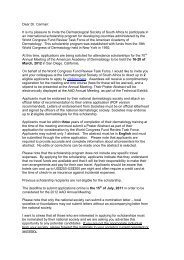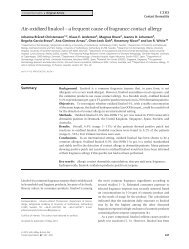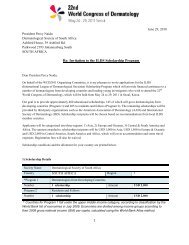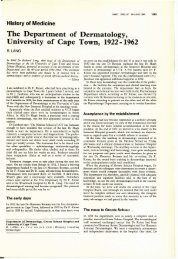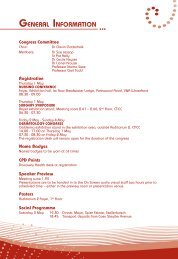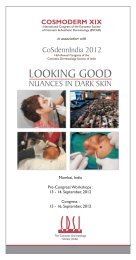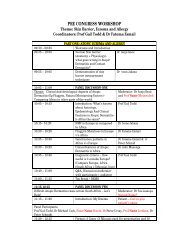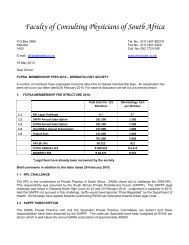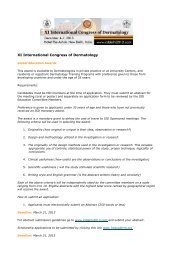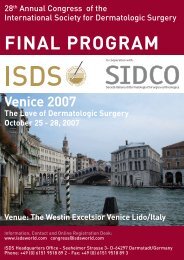Guidelines on the Management of Atopic Dermatitis ... - Dermatology
Guidelines on the Management of Atopic Dermatitis ... - Dermatology
Guidelines on the Management of Atopic Dermatitis ... - Dermatology
Create successful ePaper yourself
Turn your PDF publications into a flip-book with our unique Google optimized e-Paper software.
c<strong>on</strong>clusively linked to atopic aetiology and it is a major factor in cause <strong>of</strong> flares <strong>of</strong><br />
dermatitis. 3,4 [1-;B] Whilst all comp<strong>on</strong>ents <strong>of</strong> <strong>the</strong> “hygiene hypo<strong>the</strong>sis” may c<strong>on</strong>tribute to a<br />
rising prevalence <strong>of</strong> allergic disorders, it must be remembered that <strong>the</strong>y are<br />
epidemiologically linked to atopy, but would certainly not be important or useful in individual<br />
families. Such factors include birth by vaginal delivery, living <strong>on</strong> a farm, reduced<br />
c<strong>on</strong>sumpti<strong>on</strong> <strong>of</strong> antibiotics in infants, living in less hygienic circumstances, day-care<br />
attendance and living within <strong>the</strong> c<strong>on</strong>text <strong>of</strong> more siblings. 5<br />
The current role <strong>of</strong> probiotic supplementati<strong>on</strong> is unclear. [1++; 0] Unfortunately, <strong>the</strong>re are<br />
studies supporting benefit <strong>of</strong> probiotics in preventi<strong>on</strong>, 6,7,8 and studies that fail to support<br />
benefit. 9,10,11 The ultimate answer to <strong>the</strong> probiotic strategy may well depend <strong>on</strong> actual<br />
bacterial strains (not all organisms have equal benefit), dose, viability and timing <strong>of</strong><br />
interventi<strong>on</strong>. There is insufficient evidence at present to give a clear recommendati<strong>on</strong>.<br />
The role <strong>of</strong> breastfeeding is also unclear. Studies <strong>of</strong> exclusive breastfeeding are equivocal in<br />
<strong>the</strong>ir findings. 12,13,14 There is now mounting evidence that <strong>the</strong> most valuable allergy<br />
preventi<strong>on</strong> strategy is four m<strong>on</strong>ths <strong>of</strong> exclusive breastfeeding, followed by weaning between<br />
four and six m<strong>on</strong>ths <strong>of</strong> age, to a diet that incorporates gradual and c<strong>on</strong>sistent introducti<strong>on</strong> <strong>of</strong><br />
a wide range <strong>of</strong> foods – even those known to be allergenic (cow‟s milk, egg, peanuts, wheat<br />
and fish). 15,16 [1++; A] In high-risk infants who cannot be breastfed, <strong>the</strong>re is evidence that<br />
hypo-allergenic milk formulae may be beneficial. 17,18 [2+; B] These include partially<br />
hydrolysed whey formulae and extensively hydrolysed casein- and whey-based formulae.<br />
Where cost is an important c<strong>on</strong>siderati<strong>on</strong>, <strong>the</strong>re is <strong>on</strong>e study that has documented <strong>the</strong><br />
benefit <strong>of</strong> partially hydrolysed whey milk. 18 There is evidence that omega-3 polyunsaturated<br />
fatty acids (n-3 PUFA) supplementati<strong>on</strong> during pregnancy will reduce some food allergy<br />
sensitivities, 19 however, this effect was not seen for supplementati<strong>on</strong> <strong>of</strong> maternal diet during<br />
lactati<strong>on</strong>. 19 [2+; C]There is no clear evidence for preventi<strong>on</strong> <strong>of</strong> atopic dermatitis by<br />
supplementing <strong>the</strong> ne<strong>on</strong>atal or infant diet with n-3 PUFA. 20<br />
Primary Preventi<strong>on</strong> <strong>of</strong> Atopy:<br />
The <strong>on</strong>ly practical advice that can be given to <strong>the</strong> parents <strong>of</strong> so<strong>on</strong>-to-be born or newborn<br />
high-risk infants is to exclusively breastfeed for <strong>the</strong> first four m<strong>on</strong>ths <strong>of</strong> life and<br />
not to smoke during pregnancy or around young children.<br />
Sec<strong>on</strong>dary preventi<strong>on</strong> – preventi<strong>on</strong> <strong>of</strong> <strong>the</strong> atopic march<br />
The administrati<strong>on</strong> <strong>of</strong> newer anti-histamines to clearly atopic infants with dermatitis had<br />
initially shown some promise in <strong>the</strong> overall preventi<strong>on</strong> <strong>of</strong> asthma, but this is no l<strong>on</strong>ger <strong>the</strong><br />
case. The ETAC study found that a sub-set <strong>of</strong> atopic infants had a reduced prevalence <strong>of</strong><br />
wheeze after receiving cetirizine 21 . A study <strong>of</strong> levocetirizine for asthma preventi<strong>on</strong>, however,<br />
failed to provide benefit. 22 [2+; B]Specific immuno<strong>the</strong>rapy shows promise, but is clearly<br />
impractical unless orally available. 23 Newer immuno<strong>the</strong>rapy vaccines, and especially those<br />
that include bacterial products, are showing promise. 23 [3; C]The role <strong>of</strong> probiotics in<br />
sec<strong>on</strong>dary or tertiary preventi<strong>on</strong> is unclear. 24 The use <strong>of</strong> aqueous creams <strong>on</strong> <strong>the</strong> skin <strong>of</strong> newborn<br />
infants has been linked to an increased rate <strong>of</strong> dermatitis in children. 25 [3; B]<br />
Tertiary preventi<strong>on</strong>



